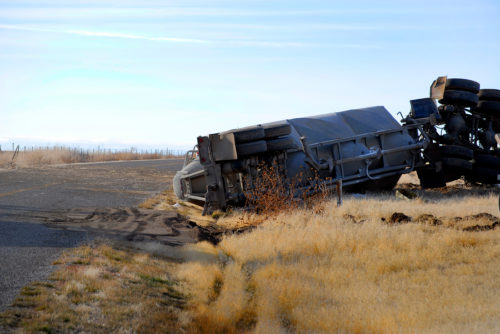When cruising down a highway, there is often nothing more intimidating than driving side-by-side with a semi-truck. Semi-trucks are large and unwieldy, and any passenger vehicle will feel small in comparison. As it turns out, a healthy fear of semi-trucks is warranted: In 2017, there were 148,000 people injured in crashes involving large trucks, including 4,761 fatalities.
One risk posed by semi-trucks is the risk of a rollover. Given the size and weight distribution of these big rigs, they are more susceptible to rollovers than other types of vehicles. Unfortunately, rollovers can be particularly dangerous for the occupants of the semi-trucks and of any other vehicle involved in the crash.
Read on to understand why rollovers occur, the unique rollover risks presented by semi-trucks, and what to do if you are involved in a rollover accident.
What Is a Rollover Accident?
The name “rollover accident” seems self-explanatory, but there are actually two types of rollover accidents:
- Tripped rollovers: Tripped rollovers are most common when only one vehicle is involved in the crash. In fact, 95 percent of single-vehicle rollovers are tripped rollovers. These types of rollovers occur when a vehicle leaves the roadway, slides sideways, and either digs its tires into soft soil or strikes an object, like a curb or guardrail. The soil or object applies force to, and slows, the lower half of the vehicle. The overexertion of force on the top half of the vehicle causes it to rollover.
- Untripped rollovers: These types of rollovers are less common and primarily happen to top-heavy vehicles. No object impedes the lower half of the vehicle. Instead, a sudden movement at high speed may cause uneven weight distribution. The top-heavy nature of the vehicle and the lack of balance cause the vehicle to rollover.
No matter the cause of the rollover, if a rollover occurs with a semi-truck, someone is likely to get injured—whether it is an occupant of the semi-truck or another vehicle on the road. In fact, 48 percent of large truck occupant deaths in 2017 occurred in crashes where the truck rolled over. This percentage is significantly higher than the rate of deaths in cars involved in a rollover, which was only 22 percent.
Causes of Rollovers in Semi-Trucks
Many general factors contribute to rollovers in all vehicles, including traveling at faster speeds, consuming alcohol, and driving on uneven or slick roads. These factors will certainly contribute to rollovers in semi-trucks. There are several factors, however, which have proven particularly relevant to semi-truck rollover accidents. An analysis of large truck rollover crashes, based on the Large Truck Crash Causation Study undertaken by the Federal Motor Carrier Safety Administration, found that the following factors were most relevant to large truck rollovers:
- Speed
- Lack of attention
- Control
- Weight of truckloads
Each of these factors is discussed in more detail below.
Speed
Speed was a factor in 45 percent of the rollover accidents analyzed in the report. While simply traveling at excessive speeds may seem to be the obvious issue, the real issue is anytime a truck is traveling at a speed faster than the conditions warrant, regardless of the speed limit. Circumstances that might warrant a more cautious speed include:
- Around curves;
- At intersections that require tight turns;
- When the truck is carrying a heavy load;
- In road stretches where there is a limited sight distance;
- When there is inclement weather; and
- If there are poor road conditions.
Speed is a critical factor for semi-trucks given the likelihood that these trucks are carrying significant loads. Rollovers are likely to occur when the front wheels of the truck turn more quickly than the cargo being carried, and the faster the speed of the vehicle, the greater the difference will be. Therefore, the faster the speed, the more likely a rollover will occur.
Lack of Attention
Truck drivers are particularly prone to suffering from attentiveness while driving due to the long hours and mindless stretches of road they regularly navigate. Truck drivers can drive up to 3,000 miles per week and as many as 11 hours a day. These long days can cause driver fatigue and can encourage distracted driving. Anything causing a driver to give less than full attention to driving is considered distracted driving, including conversations with passengers, eating, changing the radio station, or talking on a cell phone.
One leading cause of rollovers was found to be inattention that then required the driver to make a sudden change in direction or speed, resulting in a rollover. Another cause was falling asleep at the wheel or being so drowsy that the driver was unaware of what was happening. This caused drivers to drift off the road and rolling over, either due to contact with soil or an object such as a guardrail. In less frequent instances, the driver attempted to quickly steer back onto the road, with the quick change in motion causing the rollover.
Control
The most common control issue resulting in rollovers are those related to steering. This is because improper or sudden changes in steering can affect the balance of the vehicle. These steering issues can include over-steering, under-steering, and overcorrecting. Additional control issues contributing to semi-truck rollover accidents include:
- Keeping insufficient distance between the vehicle ahead;
- Responding to road conditions incorrectly;
- Failure to downshift for speed control; and
- Improper braking
The size, weight, and handling requirements of semi-trucks make them particularly prone to rollovers.
Risks of Semi-Truck Rollovers
If a semi-truck rollover occurs, the chances of injury, death, and property damage are high. A rollover will cause significant motion as the vehicle flips onto its side and roof. Even if using a seat belt restraint appropriately, occupants are likely to come into contact with objects flying around inside the truck. If a seat belt is not used, the chances of injury increase exponentially. When a seat belt is not worn, rollovers present a high risk of ejection. The turning of the vehicle accompanied by the shattering or deformation of windows increase the chances that an occupant will be thrown from the car.
The likelihood of injuries or fatalities increases whenever a rollover occurs. National statistics show that close to 30 percent of traffic fatalities were the result of a rollover. Kentucky saw 724 traffic fatalities in 2018, and 169 involved a rollover. Even when there are no fatalities, the injuries occurring as the result of a rollover can be quite severe, including:
- Traumatic head and brain injuries: Given the likelihood that occupants will be thrown around inside the truck or ejected, head and brain injuries are common, including skull fractures, laceration, and brain injuries. These injuries are likely to have life long impacts.
- Spinal cord injuries: Given the force exerted on the vehicle and the body, serious back injuries are often a result of rollover accidents.
- Neck injuries: Occupants experience whiplash, herniated discs, slipped discs, and nerve damage after a rollover accident.
- Broken bones: As occupants brace themselves or come into contact with objects in the truck, they may suffer broken bones.
- Cuts, bruises, and soft tissue injuries: The body is likely to take a beating during a rollover, including torn ligaments and pulled muscles
The above injuries are commonly seen for occupants of vehicles involved in rollovers. It is important to also acknowledge that individuals who are not an occupant of the rollover vehicle are also likely to be injured. Unless a semi-truck is traveling on a completely empty road at the time of the roll-over, it may come into contact with other vehicles. Additionally, its cargo is likely to spill across the roadway, creating obstacles for other drivers. The size and weight of a semi-truck and the likelihood that its cargo will block the roadway mean that occupants of other vehicles affected by the rollover are likely to suffer serious and long term injuries as well.
In addition to injuries, there is likely to be significant damage to the semi-truck, its cargo, and any other vehicle involved in the accident.
Preventing Semi-Truck Rollovers

- Sufficient training: To drive a commercial truck in Kentucky, any driver will need to have a Commercial Driver’s License (CDL). This will require that the driver pass a CDL exam that includes pre-trip inspection, basic skills, and road skills testing. There is not, however, for any additional or ongoing training. Drivers can take many CDL training courses in Kentucky. Ensuring that drivers receive proper training, including training that identifies rollovers, their causes, and prevention, will go a long way in reducing the frequency of rollover accidents for large trucks.
- Regular maintenance: While many rollovers are due to driver action or inaction, vehicle maintenance also plays an important role. For example, tire blowouts and other tire issues are common contributors to rollovers. Drivers should ensure that their tires are the appropriate size and design for their vehicle and vehicle loads. They should also regularly check tire pressure and tire tread to ensure they are functioning optimally. Locked brakes are another cause of rollovers, so special attention should be paid to brake maintenance. No matter what, all drivers should ensure that their truck receives its scheduled maintenance.
While special attention should be paid to the above, common sense factors will also go a long way in reducing rollovers and the severity of injuries:
- Keeping an eye on speed;
- Avoiding alcohol consumption;
- Wearing a seatbelt; and
- Ensuring airbags are functioning appropriately.
What to Do After a Rollover
If you have been involved in a truck accident, whether as an occupant or another vehicle, you may be confused about what your options are for addressing any personal injuries and property damage. First, be sure to take care of yourself. Seek out the necessary medical attention. Even if you do not believe you have any major injuries, it is still important to see a doctor. The adrenaline from the event may mask injuries, and failure to immediately document an injury could limit your ability to recover from an insurance company.
After making sure your injuries are taken care of, it will be important to determine whether another party may have been at fault for the crash. Be sure to secure a police report, document witness contact information, and take photos of the accident scene. All this information will be helpful if you need to develop a case against another party.
If you were the driver of the semi-truck involved in the rollover, you should consider whether:
- Another vehicle was involved and potentially at fault;
- Your employer required you to drive more miles or hours than allowed under federal law;
- Your employer failed to perform routine maintenance on the truck you were driving; or
- Roads were poorly maintained.
If you were in another vehicle involved in the semi-truck rollover, you should investigate:
- Whether the semi-truck driver exhibited poor control of the vehicle or violated any traffic laws;
- If the truck experienced any type of mechanical failure;
- If the driver was complying with all federal requirements around driving hours and miles; and
- If roads were poorly maintained.
All drivers involved in the accident should explore whether their vehicle responded appropriately, including whether airbags appropriately deployed. Any failures in safety mechanisms will contribute to the seriousness of injuries. The manufacturer should be responsible for injuries resulting from these failures.
Given the number of federal laws surrounding truck drivers, the complexity of truck maintenance, and the many possible causes of a truck rollover, it may be helpful to consult an attorney. An attorney can help you determine whether you should seek compensation from any of the involved parties. Such actions could include a lawsuit against the city or state for poor road conditions. It could include an investigation into the compliance practices of the truck driver and their employer. Additionally, an attorney can help you navigate the complicated insurance processes surrounding commercial trucks.

If you need additional assistance, an experienced personal injury attorney can provide support through every step of the post-accident process.


